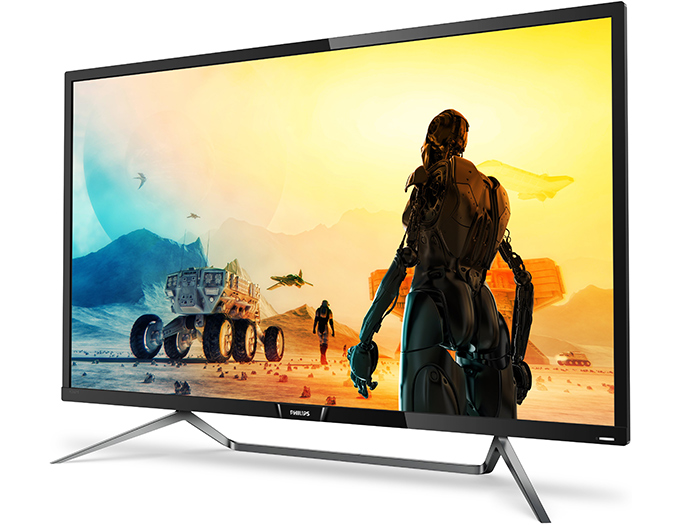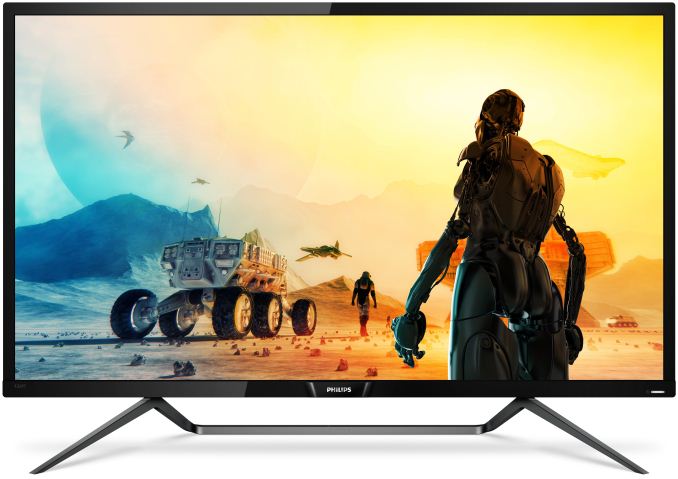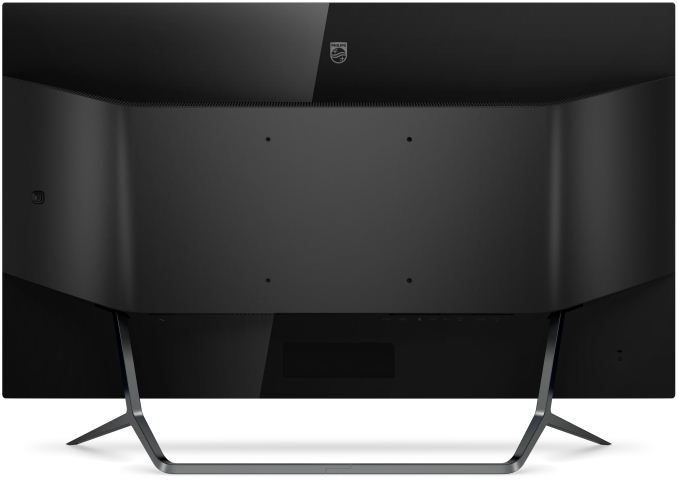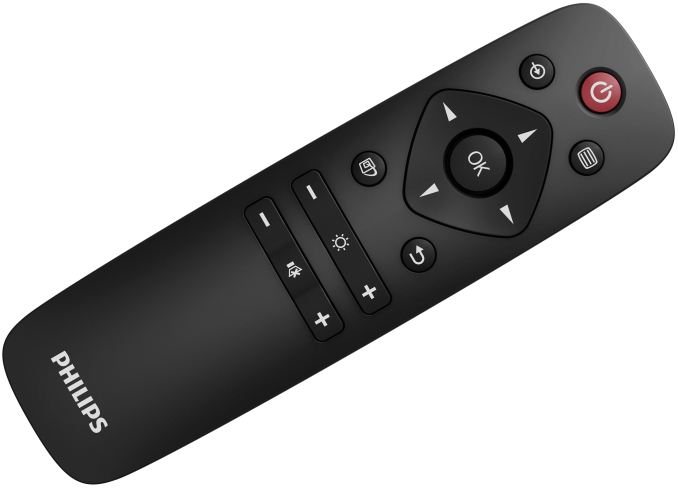Philips Unveils 43-Inch 4K Gaming LCD with DisplayHDR 1000, DCI-P3, FreeSync
by Anton Shilov on April 26, 2018 3:30 PM EST
Philips has announced its new large gaming display that brings together an ultra-high-definition resolution panel, VESA’s DisplayHDR 1000 certification, and AMD’s FreeSync dynamic refresh rate technology. In addition to being the only ultra-large gaming monitor to support the aforementioned features (among those announced to date), the Philips 436M6VBPAB also supports USB Type-C docking, which is going to please users of laptops that feature only USB-C ports.
A Gaming Display with Quantum Dots, Ambiglow, and a Remote
The Philips 436M6VBPAB relies on a 43-inch 8-bit + FRC VA panel featuring a 3840×2160 resolution, 600 – 1000 nits brightness, a high contrast ratio (since it is a VA panel, we are probably talking about something like 2000:1 or better), a 4 ms response time, a 60 Hz optimum refresh rate, 178°/178° viewing angles, and so on. The backlighting is outfitted with a Quantum Dot-enhancement film that enables it to cover an above-average 97.6% of the DCI-P3 color gamut.
In addition to accurate colors and HDR support, the 436M6VBPAB supports Philips' Ambiglow technology, which produces LED lighting effects to match ambient lighting with what is happening on the screen. This is not a programmable RGB lighting found on gaming displays from companies like ASUS, but it adds visual effects that are useful practically and bring additional immersion to games.
Speaking of gaming, it is noteworthy that the ultra-large monitor from Philips takes a page from AOC’s book and supports the so-called Low Input Lag mode that reduces input lag by bypassing “most of the display’s internal processing." This is not particularly surprising since both AOC- and Philips-branded LCDs are made by TPV.
Moving on to connectivity of the 436M6VBPAB. The monitor has four display inputs: 1x DisplayPort 1.2, 1x Mini DisplayPort 1.2, 1x HDMI 2.0, and 1x USB Type-C that can be used both for display connectivity and as an upstream port for a USB 3.0 hub. The LCD supports Picture-in-Picture and Picture-by-Picture capabilities from two sources. As for audio, the display features a 3.5-mm audio input, 3.5-mm audio output as well as two built-in 7-W speakers with the DTS Sound badge.
Another important feature of the Philips 436M6VBPAB monitor is bundled remote controller that can be used to control the monitor as well as other devices connected using HDMI (e.g., media players, game consoles, etc.). The remote is going to be quite handy because the 43-incher can be used like a TV when connected to various media streamers or players (or even a TV tuner!). Now, a disadvantage of this size is that the 436M6VBPAB does not come with a stand that can regulate its height or tilt. To partly solve this, it does have VESA mounts.
FreeSync Meets HDR
The new monitor from Philips belongs to the brand’s Momentum lineup of LCDs aimed at gamers and multimedia enthusiasts. Given the target market, the key features of the Philips 436M6VBPAB besides its dimensions and Quantum Dot-enhanced backlighting are AMD’s FreeSync technology and VESA’s DisplayHDR 1000 badge, a rather odd combination considering the fact that FreeSync 2 is a technology that is supposed to bring HDR to gaming displays. There is an explanation to this combination.
AMD’s FreeSync 2 mandates monitors to support a number of features: they have to support the tech on the logical level (i.e., let games tone map directly to the native color space of a display), they have to cover at least 90% of the DCI-P3 color space, and they have to support a dynamic refresh rate with Low Framerate Compensation. In case of the 436M6VBPAB, the LCD supports a wide color gamut and a dynamic refresh, but not direct tone mapping and LFC, which is why it cannot get an appropriate AMD certification. In fact, it yet has to get a FreeSync certification, which is why Philips uses the term ‘Adaptive Sync for AMD GPUs’. Philips does not disclose dynamic refresh range of the monitor, but given its maximum refresh rate, we don't expect the minimum refresh rate to be much below 45Hz.
Update 6:15 PM ET: Philips Australia has published official specifications of the 436M6VBPAB monitor on its website. The specs list 3840 × 2160 at 60 Hz as "optimum" resolution and refresh rate of the display. At the same time, the LCD supports a 23 - 80 Hz scanning frequency for DisplayPort and HDMI inputs, which looks like the FreeSync range. Considering that 80 Hz is an odd refresh rate, it is highly likely that the monitor overclocks itself from 60 Hz to 80 Hz in certain situations. In the meatime, since display supports a 23 - 80 Hz scanning frequency, it is more than enough for LFC.
Update 4/27: AMD confirmed on Friday that the Philips 436M6VBPAB display is FreeSync certified.
As for the DisplayHDR 1000 logo, the VESA's highest HDR has a rather strict requirements for brightness (600 nits full-screen long duration minimum, 1000 nits full-screen flash minimum) and black levels. The VESA does not mandate local dimming for this standard, yet it does not believe that corner maximum limit of 0.05 nits and tunnel maximum limit of 0.1 nits are achievable without local dimming. That said, while the Philips 436M6VBPAB does not support FALD (full array local dimming), it does support some kind of local dimming and therefore should feature a good contrast ratio.
| The Philips Momentum 43" 4K HDR display with Ambiglow | |
| 436M6VBPAB | |
| Panel | 43" MVA |
| Native Resolution | 3840 × 2160 |
| Maximum Refresh Rate | 60 Hz (normal) 80 Hz (overclocked) |
| Response Time | 4 ms GtG |
| Brightness | 720 cd/m² (typical) 1000 cd/m² (peak) |
| Contrast | 4000:1 |
| Backlighting | LED with quantum dots |
| Viewing Angles | 178°/178° horizontal/vertical |
| Aspect Ratio | 16:9 |
| Color Gamut | 100% sRGB/BT.709 97.6% DCI-P3 |
| HDR | HDR10 |
| DisplayHDR Tier | 1000 |
| Dynamic Refresh Rate Tech | AMD FreeSync 23.976 - 80 Hz |
| Pixel Pitch | 0.2479 mm² |
| Pixel Density | 102 PPI |
| Inputs | 1 × DisplayPort 1.2 1 × Mini DisplayPort 1.2 1 × HDMI 2.0 1 × USB Type-C |
| Audio | 3.5 mm input/output 2 × 7 W DTS Sound speakers |
| USB Hub | 2 × USB 3.0 Type-A connectors 1 × USB 3.0 Type-C input |
| VESA Mount | 200 × 200 mm |
| MSRP | Europe: €799 UK: £699 US: $799 without VAT (unconfirmed) |
Pricing and Availability
Philips plans to start selling the 436M6VBPAB this May for €799/£699 in Europe. As production of the unit ramps up, its availability will get more widespread in June, but the manufacturer does not explicitly say when it plans to start its sales in the U.S.
Related Reading:
- BenQ Unveils EX3203R 32-inch Curved LCD with FreeSync 2, DCI-P3, & USB-C
- AOC Announces AGON AG322QC4 32-Inch Curved LCD with FreeSync 2 & DisplayHDR 400
- Samsung Announces First Freesync 2 Monitors: CHG70 & CHG90 - Quantum Dots, Up to 49”, 144 Hz, DCI-P3
- AMD Announces FreeSync 2: Easier & Lower Latency HDR Gaming
- Microsoft and AMD to Bring FreeSync 2 Support to Xbox One S and Xbox One X This Spring
- Philips Readies Curved Ultra-Wide 492P8 Display: 49”, 32:9, USB-C, Sub-$1100
- Philips Preps 328P6AU and 328P6VU: 31.5” Professional LCDs with QHD, UHD, HDR, USB-C
- Philips Demos 328P8K: 8K UHD LCD with Webcam, Docking, Coming in 2018



















31 Comments
View All Comments
zilexa - Friday, June 15, 2018 - link
It does not have VA black crush.https://pcmonitors.info/reviews/philips-436m6vbpab...Gunbuster - Friday, April 27, 2018 - link
Dear Philips, this is 2018 at what might be peak RGB and Ambilight is nowhere to be seen. Are you asleep at the wheel?Batmeat - Friday, April 27, 2018 - link
Still waiting for a monitor like this with equal or better features and better than 60hz refresh rate. 80hz overclocked?....I really don't think so.jabber - Sunday, April 29, 2018 - link
Hmm how would this look being used as a TV? I wonder...piroroadkill - Monday, April 30, 2018 - link
This sounds nice. I'd be more than happy with a 24-80Hz refresh range, and the size and resolution mean that you could run it at 100% scaling. Nice.If only NVIDIA cards could run Freesync screens.
close - Monday, April 30, 2018 - link
Freesync is free and Nvidia is pretty alergic to free stuff. They can't go near it. That's why they came with the G-Sync version. Same stuff, for money.joos2000 - Tuesday, May 1, 2018 - link
Pretty sure that Freesync was AMD's response to nVidias G-sync.close - Wednesday, May 2, 2018 - link
The order was not the point. What was the point is that Nvidia has a paid version for everything that others are (or would be) offering for free. Refusing to support a free standard and sticking to a proprietary (paid) one that offers no benefit outside of Nvidia marketing material is an Apple-level dick move.And I say this as someone who really enjoys their Apple/Nvidia products.
Simon_Says - Monday, April 30, 2018 - link
>"8-bit + FRC"Aaand pass. No point in investing in a half-assed implementation. Better to wait two/three more years for proper panels.
JoeyJoJo123 - Monday, April 30, 2018 - link
Be sure to point me to any HDR10 enabled monitors with a true 10-bit panel, 1:4000 contrast ratio at $799 or less my way.Also, it feels like every other week that I have to link this to someone who's autistically pedantic about the use of FRC regarding color depth: http://www.tftcentral.co.uk/faq.htm#colour_depth
"An 8-bit display would offer a colour palette of 16.7 million colours. They offer a 'true' colour palette, and are generally the choice of manufacturers for colour critical displays over 6-bit panels. On the other hand modern 6-bit screens use a range of Frame Rate Control (FRC) technologies to extend the colour palette from 262,144 colours to around 16.7m. In fact on many modern panels these FRC are very good and in practice you’d be hard pressed to spot any real difference between a 6-bit + FRC display and a true 8-bit display. Colour range is good, screens show no obvious gradation of colours, and they show no FRC artefacts or glitches in normal everyday use. Most average users would never notice the difference and so it is more important to think about the panel technology and your individual uses than get bogged down worrying about 6-bit vs. 8-bit arguments."
The very fact of the matter that an 8bit + FRC monitor can attain the highest HDR10 rating of 1000 should be noted since it apparently qualifies for VESA's highest HDR10 standard right now, even over 10-bit computer monitors, should speak for itself. FRC vs no-FRC hasn't mattered for years. FRC are very good in practice today.